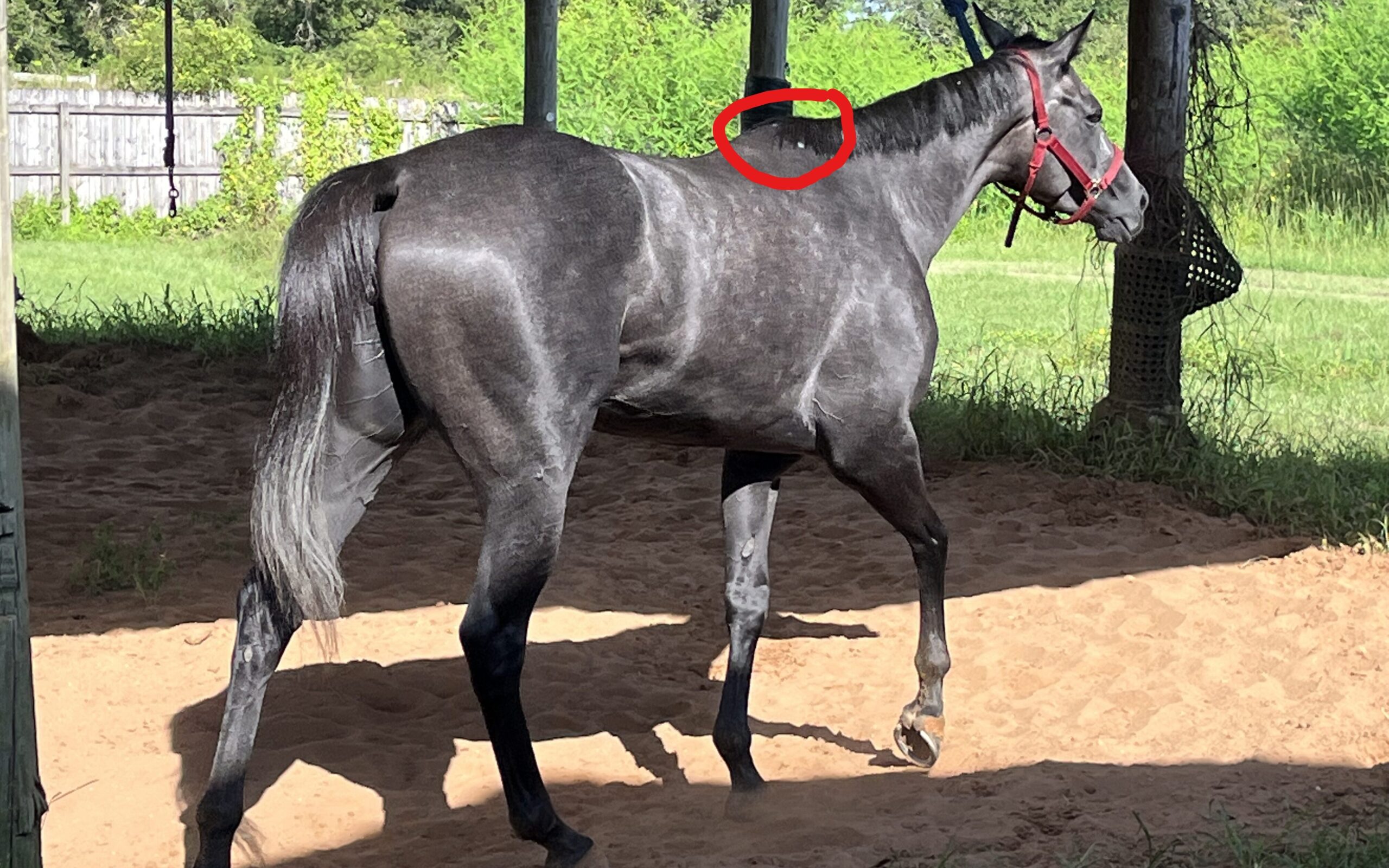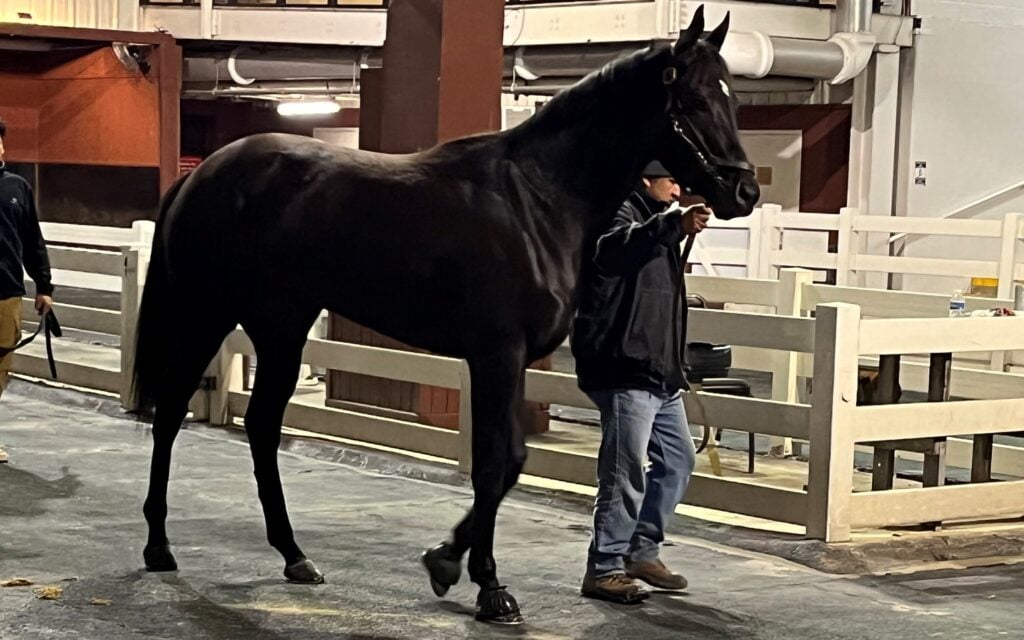Last updated: December 8, 2023
Any links on this page that lead to products on Amazon are affiliate links and I earn a commission if you make a purchase. Thanks in advance – I really appreciate it!
If you’ve ever ridden a horse bareback that has exceptionally high withers, then you probably know exactly where it is. But horse withers come in different shapes and sizes and play a critical role in horse conformation and performance.
The withers are the highest point of a horse’s back, right between the shoulder blades. This is the standard point for measuring a horse’s height. Horse withers are an integral part of the horse’s anatomy. It connects ligaments and muscles from the neck and back and acts as a central point for the horse’s movement.
A horse’s withers are often the last part of its anatomy that people consider. However, withers are a vital part of the horse’s back. This comprehensive guide looks at what withers are and what they do, how to care for your horse’s withers, and what some common problems are.
What are Horse Withers?
If you’re like most people, that’s a question you’ve never considered. But, if you’re thinking about buying or breeding horses, you should know about them. Because good withers on a horse are critical to a healthy neck and spine. To understand their importance, let’s start with the basics and learn what they are and their function.

Withers on horses is part of the spinal column that projects upwards between the shoulder blades of a horse at the base of the horse mane. It is the tallest point of the horse that doesn’t move and where horses are measured in height.
The withers include the dorsal spinal process from the third to the eleventh thoracic vertebrae, which vary in size and height, giving the withers an arched appearance.
The name was derived from Old English when horses were used as draft animals. The word withers meant “against,” this explained the part of the horse where the harness pushed against the load it was hauling.
Here is a short but very informative YouTube video about horse withers.
What do Horse Withers Do?
The withers are an essential part of the horse’s anatomy, as they provide support and stability for the animal during movement. The way the withers and shoulders are put together will influence the length and motion of the stride, making it an important factor in a horse’s movement and balance.
A horse’s withers create an anchor point for most connective tissue and elastic ligaments connecting the forelimbs and back muscles. Apart from being an anchor for a saddle when mounting and dismounting, the withers play a pivotal role in the biomechanics of the horse’s free-flowing movements.
Another critical role of a horse’s withers is that it is a central point between the neck and back, acting as a lever point, so the back elevates when the horse lowers its head and neck. This central point is essential for the horse to create a collected movement.
For these reasons, it is vital to pay close attention to the withers when assessing a horse’s conformation.

How to Tell if Your Horse has Healthy Withers.
The health of a horse’s withers can be affected by its movement, how it is ridden, its lifestyle, and its tack. A horse demonstrating healthy withers will be relaxed and can freely move and extend in all gaits.
The ability of the horse to engage and carry out collected work properly is also a sign that the horse’s withers are healthy and pain-free. Horses with well-toned symmetrical muscles on either side of the withers are signs that the horse has healthy withers.
It’s always important to check your horse’s back and withers for signs of soreness, swelling, or heat. If your horse is relaxed and doesn’t show signs of a cold back, bucking, twitching its tail, or aggressively trying to bite you, then it’s a sign that you have a horse with healthy withers.

Sore Withers
Several different things can cause sore withers, including poor saddle fit, incorrect saddling technique, and repetitive motions. In some cases, the problem may be due to an underlying health condition such as arthritis.
Regardless of the cause, sore withers can be very painful for horses and make it difficult for them to move comfortably. If you suspect your horse has sore withers, you should have him examined by a veterinarian to get a proper diagnosis and treatment plan.
Signs Of Sore Withers
As we previously mentioned, several contributing factors create a sore withers. If you suspect the horse has sore withers, you need to seek the advice of your vet or saddle fitter to assess the situation and pinpoint the cause of the problem.
- Swelling or heat in the withers
- Shows signs of aggression when putting the saddle on
- Hollowing its back, bucking, or evading you when mounting.
- Resistance moving forward
- Shortening of strides
- Having difficulty engaging
- Starts refusing fences or not lifting its legs properly over the fences
- You will notice white hair around the withers area
- The asymmetrical muscle tone of the shoulders
- Your horse starts to lose muscle tone at the withers and shoulders.
How To Prevent Sore Withers
Unless your horse has rolled or fallen onto its withers, most problems stem from ill-fitting tack and equipment, which can be reasonably easy to manage. Saddle pads and blankets should be cleaned and regularly inspected for holes or dry hard patches that could cause abrasions on the withers.
Ensure your saddle pad is long enough and extends past your saddle to prevent chafing. Saddles should be checked regularly to ensure they fit the horse. They may need to be adjusted by adding flocking to the panels or be replaced entirely if they no longer fit. Having your saddle checked at the end of winter and summer is a good starting point.

How should a Saddle Fit a Horse’s Withers?
Saddles can often cause unhealthy withers, causing many performance issues and restricting the horse’s movement. That’s why ensuring the saddle fits the withers correctly is vital. When you fit a saddle to a horse, you must ensure that the saddle’s gullet has at least two to three fingers clearance above the horse’s withers.
This space compensates for the rider’s weight in the saddle and when the panels settle. Suppose a saddle is fitted too close to the withers. In that case, the saddle will cause pressure points and sores on the withers, ultimately affecting the horse’s performance.
Not all horses are blessed with perfect conformation and gentle sloping withers with well-toned shoulder muscles that can support the saddle. Some horses have high protruding withers with hollowed or atrophied muscles on either side.
The hollows on either side of the withers must be filled up with a correction pad that will imitate the muscles to help support the saddle and keep it from pressing down on the withers.

The saddle panels should not sit directly against the top edge of the withers. Instead, find a saddle where the panels start two fingers below the top of the wither bone. It is essential to check your saddle periodically as not all saddle panels are flocked the same way and may collapse or compact differently. In addition, the compaction of the panels will affect the space between the gullet and the horse’s withers.
Horses can also change and develop atrophied muscles in the withers area once they have a well-fitted saddle. Atrophied muscles will affect the balance and fit of the saddle on the horse.

What are Common Problems with Horse Withers?
Horse withers come in various forms, shapes, and sizes that can affect a horse and its tack. High protruding withers, also called knife blades, tend to be prominent and generally have hollowed pockets on either side, making fitting saddles challenging.
On the other side of the spectrum, you have low round withers known as mutton withers. Unfortunately, these withers also pose a problem for saddle fitting as most of these come with loaded shoulders that allow the saddle to ride up the neck.
Kissing spine is when two or more vertebrae are close to each other and touch, causing inflammation in the spine. Although this condition is found more in the horse’s back, it can also be found in the withers area, which makes it difficult for horses to flex and extend their backs.
Apart from having your saddle professionally fitted, you must also ensure that blankets fit the horse correctly. Ill-fitting blankets can also be to blame for rubbing or causing pressure points.
Saddle pads are another cause of problems with withers. The saddle needs to clear the withers to prevent chafing, as does the saddle pad. Saddle pads that slip down and push over the withers will cause irritation, swelling, and sores.

How To Care For Your Horse’s Withers
As any horse owner knows, the withers are an important part of a horse’s anatomy. Not only do they support the horse’s weight, but they also provide attachment points for the muscles and tendons that allow the horse to move. As a result, it is important to take care of the withers and keep them healthy.
First, brush your horse’s withers regularly, especially before saddling. This will help to remove any dirt or debris that could cause irritation.. Next, check the withers for any signs of inflammation or swelling. If you notice anything out of the ordinary, consult with a veterinarian.
As the withers connect many other muscles and ligaments to the neck and back, the horse may have hurt its back and neck as compensation for the pain. You can also have a physiotherapist look at the horse’s back.
Treat open wounds immediately. Any open wound on the withers should be cleaned with saline solution and treated with an antiseptic wound ointment. Applying fly spray around the edges with a cloth will help control flies around the wound.
The area should be left open to dry and heal, the horse should be given rest from its work schedule, and tack should be kept off until they have recovered. A cold compress will help reduce the swelling if the withers are swollen.
Following these simple tips can help ensure that your horse’s withers stay healthy and strong.
Conclusion
Horse withers are one of those areas that gets the least consideration until there is a problem, and it affects the horse in various ways. Looking after your horse’s withers by ensuring the tack and equipment fits correctly is a step toward ensuring your horse’s happiness.
FAQs
Is high withers on a horse bad?
Not necessarily. High withers can indicate a well-bred and muscular horse. However, in some breeds, high withers signify poor conformation. In addition, horses with high withers often need special saddles to accommodate them.
What is a mutton withered horse?
Mutton-withered horses’ are the opposite of high-withered horses. They typically have little to no defined wither. Their back slopes gradually towards their rear, and the shoulder doesn’t have much definition. Mutton-withered horses are less ideal for many activities and are prone to back problems.
References
- https://en.wikipedia.org/wiki/Withers
- https://www.manitobacooperator.ca/livestock/reading-the-withers/
- https://ker.com/equinews/whither-withers-horse/
- https://ker.com/equinews/horse-withers-more-saddle-stay/
- https://www.albertafarmexpress.ca/columns/horse-health/theres-a-lot-to-be-learned-by-reading-a-horses-withers/#:~:text=Healthy%20withers%20are%20’full’%20rounded,imbalance%20or%20atrophy%20(loss).
- https://practicalhorsemanmag.com/health-archive/sore-horse-withers-27832/

About the Author: Miles Henry
Lifelong Horseman | Racehorse Owner | Published Author
Miles Henry brings over 25 years of hands-on experience training and owning Thoroughbred racehorses. Raised with Quarter Horses and Appaloosas, he’s spent a lifetime learning from horses—on the track, in the barn, and in the field. Today, he runs a small but successful racing stable in Louisiana and shares real-world insights on HorseRacingSense.com, helping horse owners, fans, and bettors navigate the sport with confidence.
📚 Books: View Miles’s books on Amazon »
🎧 Podcast Guest: Animal Tales Ep. 32 |
YouTube Interview
📩 Newsletter: Sign up for racing tips and horse care advice »
🔗 Follow Miles:
Twitter |
Facebook |
YouTube


